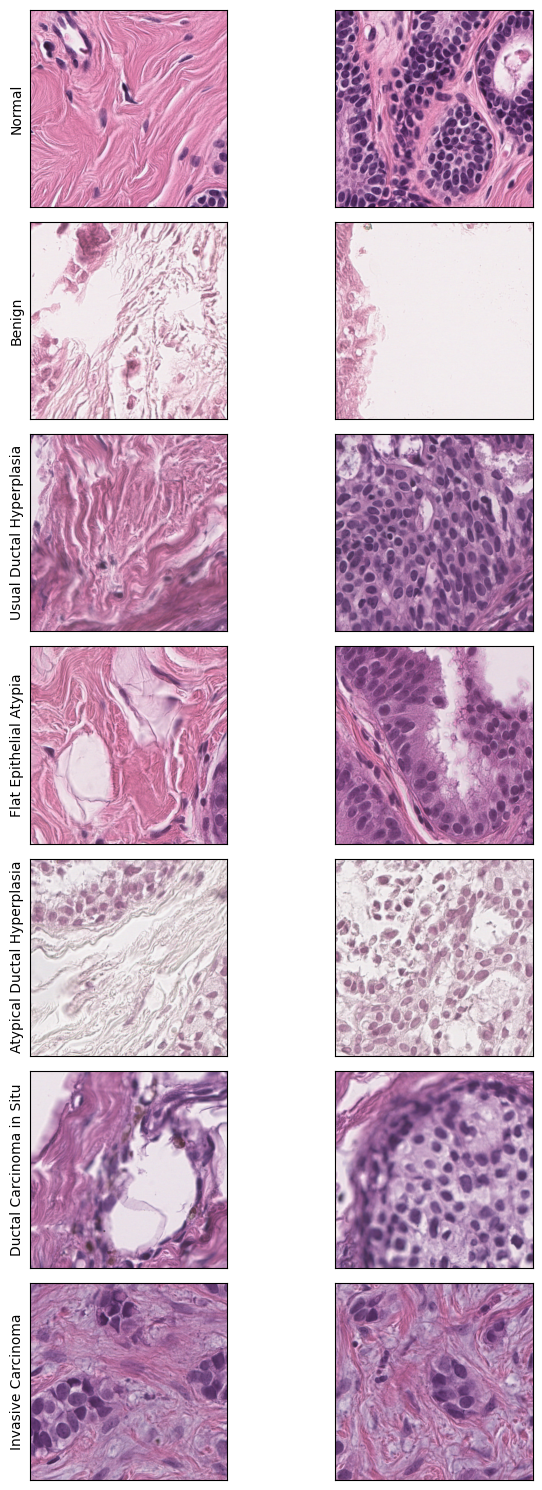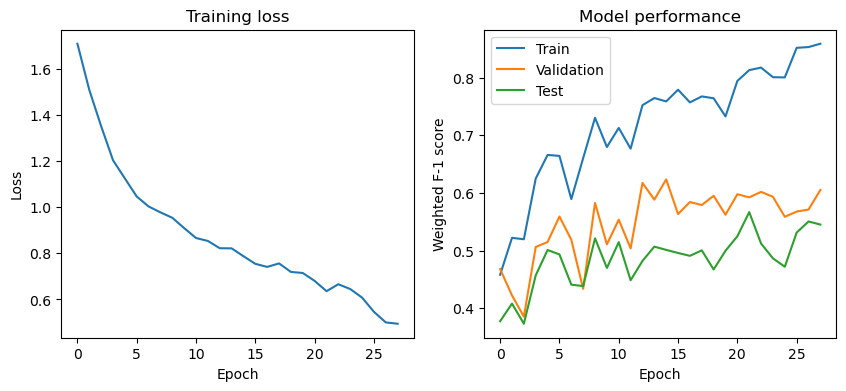Machine Learning: Training a HACTNet model
In this notebook, we will train the HACTNet graph neural network (GNN) model on input cell and tissue graphs using the new pathml.graph API.
To run the notebook and train the model, you will have to first download the BRACS Regions of Interest (ROI) set from the BRACS dataset. To do so, you will have to sign up and create an account. Next, you will have to construct the cell and tissue graphs using the tutorial in examples/construct_graphs.ipynb. Use the output directory specified there as the input to the main function in this tutorial.
NOTE: The actual HACTNet model uses HoVer-Net, an ML model, to detect cells. In examples/construct_graphs.ipynb, we used a manual method for simplicity. Hence the performance of the model trained in this notebook will be lesser.
[12]:
import os
from glob import glob
import argparse
from PIL import Image
import numpy as np
from tqdm import tqdm
import torch
import h5py
import warnings
import math
from skimage.measure import regionprops, label
import networkx as nx
import traceback
from glob import glob
import matplotlib.pyplot as plt
import torch
import torch.nn as nn
from torch_geometric.data import Batch
from torch_geometric.data import Data
from torch.utils.data import Dataset
from torch_geometric.loader import DataLoader
from torch.optim.lr_scheduler import StepLR
from sklearn.metrics import f1_score
from pathml.core import HESlide
from pathml.datasets import EntityDataset
from pathml.ml.utils import get_degree_histogram, get_class_weights
from pathml.ml import HACTNet
# If using GPU
device = "cuda"
# If using CPU
# device = "cpu"
Data visualization
First, let us take a look at the inputs to our model. The dataset comrpises of approximately 3600 training ROIs, 310 validation ROIs and 560 testing ROIs. In each of these, the ROIs can belong to one out of seven possible labels, that correspond to breast cancer subtypes. Refer to Brancati et al., 2022 for more information about the dataset. Our task is to train a model that can classify the given ROI to the correct cancer subtype.
We will now visualize one ROI from each of these seven subtypes to see the similarities and differences between them.
[21]:
# PATH to the train split of the BRACS dataset
base_path = '../../data/BRACS_RoI/latest_version/train/'
# We manually choose a random ROI to visualize along with information about its corresponding label
image_info = [('0_N/BRACS_1231_N_27.png','Normal'),
('1_PB/BRACS_1003671_PB_1.png', 'Benign'),
('2_UDH/BRACS_1003707_UDH_1.png', 'Usual Ductal Hyperplasia'),
('3_FEA/BRACS_1003693_FEA_1.png', 'Flat Epithelial Atypia'),
('4_ADH/BRACS_1003728_ADH_1.png', 'Atypical Ductal Hyperplasia'),
('5_DCIS/BRACS_1003697_DCIS_1.png', 'Ductal Carcinoma in Situ'),
('6_IC/BRACS_1003699_IC_1.png', 'Invasive Carcinoma')]
# Plot the figure
fig, axarr = plt.subplots(nrows=7, ncols=2, figsize=(7.5, 15))
for i, (image_path, label) in enumerate(image_info):
wsi = HESlide(base_path + image_path)
region1 = wsi.slide.extract_region(location=(0, 0), size=(500, 500))
region2 = wsi.slide.extract_region(location=(500, 500), size=(500, 500))
axarr[i,0].imshow(np.squeeze(region1))
axarr[i,1].imshow(np.squeeze(region2))
axarr[i,0].set_ylabel(label, fontsize=10)
for a in axarr.ravel():
a.set_xticks([])
a.set_yticks([])
plt.tight_layout()
plt.show()

Model Training
Now that we know the input dataset and the objective, we can proceed to training the model. The model takes constructed graphs as input, so make sure you have run examples/construct_graphs.ipynb.
We can define the main training loop for loading the constructed graphs, initializing the model and training.
[12]:
def train_hactnet(
train_dataset,
val_dataset,
test_dataset,
batch_size=4,
load_histogram=True,
histogram_dir=None,
calc_class_weights=True,
):
# Print the lengths of each dataset split
print(f"Length of training dataset: {len(train_dataset)}")
print(f"Length of validation dataset: {len(val_dataset)}")
print(f"Length of test dataset: {len(test_dataset)}")
# Define the torch_geometric.DataLoader object for each dataset split
train_batch = DataLoader(
train_dataset,
batch_size=batch_size,
shuffle=True,
follow_batch=["x_cell", "x_tissue"],
drop_last=True,
)
val_batch = DataLoader(
val_dataset,
batch_size=batch_size,
shuffle=False,
follow_batch=["x_cell", "x_tissue"],
drop_last=True,
)
test_batch = DataLoader(
test_dataset,
batch_size=batch_size,
shuffle=False,
follow_batch=["x_cell", "x_tissue"],
drop_last=True,
)
# The GNN layer we use in this model, PNAConv, requires the computation of a node degree histogram of the
# train dataset. We only need to compute it once. If it is precomputed already, set the load_histogram=True.
# Else, the degree histogram is calculated and saved.
if load_histogram:
histogram_dir = "./"
cell_deg = torch.load(os.path.join(histogram_dir, "cell_degree_norm.pt"))
tissue_deg = torch.load(os.path.join(histogram_dir, "tissue_degree_norm.pt"))
else:
train_batch_hist = DataLoader(
train_dataset,
batch_size=20,
shuffle=True,
follow_batch=["x_cell", "x_tissue"],
)
print("Calculating degree histogram for cell graph")
cell_deg = get_degree_histogram(train_batch_hist, "edge_index_cell", "x_cell")
print("Calculating degree histogram for tissue graph")
tissue_deg = get_degree_histogram(
train_batch_hist, "edge_index_tissue", "x_tissue"
)
torch.save(cell_deg, "cell_degree_norm.pt")
torch.save(tissue_deg, "tissue_degree_norm.pt")
# Since the BRACS dataset has unbalanced data, it is important to calculate the class weights in the training set
# and provide that as an argument to our loss function.
if calc_class_weights:
train_w = get_class_weights(train_batch)
torch.save(torch.tensor(train_w), "loss_weights_norm.pt")
# Here we define the keyword arguments for the PNAConv layer in the model for both cell and tissue processing
# layers.
kwargs_pna_cell = {
"aggregators": ["mean", "max", "min", "std"],
"scalers": ["identity", "amplification", "attenuation"],
"deg": cell_deg,
}
kwargs_pna_tissue = {
"aggregators": ["mean", "max", "min", "std"],
"scalers": ["identity", "amplification", "attenuation"],
"deg": tissue_deg,
}
cell_params = {
"layer": "PNAConv",
"in_channels": 514,
"hidden_channels": 64,
"num_layers": 3,
"out_channels": 64,
"readout_op": "lstm",
"readout_type": "mean",
"kwargs": kwargs_pna_cell,
}
tissue_params = {
"layer": "PNAConv",
"in_channels": 514,
"hidden_channels": 64,
"num_layers": 3,
"out_channels": 64,
"readout_op": "lstm",
"readout_type": "mean",
"kwargs": kwargs_pna_tissue,
}
classifier_params = {
"in_channels": 128,
"hidden_channels": 128,
"out_channels": 7,
"num_layers": 2,
}
# Initialize the pathml.ml.HACTNet model
model = HACTNet(cell_params, tissue_params, classifier_params)
# Set up optimizer
opt = torch.optim.Adam(model.parameters(), lr=0.0005)
# Learning rate scheduler to reduce LR by factor of 10 each 25 epochs
scheduler = StepLR(opt, step_size=25, gamma=0.1)
# Send the model to GPU
model = model.to(device)
# Define number of epochs
n_epochs = 60
# Keep a track of best epoch and metric for saving only the best models
best_epoch = 0
best_metric = 0
# Load the computed class weights if calc_class_weights = True
if calc_class_weights:
loss_weights = torch.load("loss_weights.pt")
# Define the loss function
loss_fn = nn.CrossEntropyLoss(
weight=loss_weights.float().to(device) if calc_class_weights else None
)
# Empty list to append training losses
train_losses = []
# Empty list to append validation metrics (wighted F-1 score)
train_metrics = []
val_metrics = []
test_metrics = []
# Define the evaluate function to compute metrics for validation and test set to keep track of performance.
# The metrics used are per-class and weighted F1 score.
def evaluate(data_loader):
model.eval()
y_true = []
y_pred = []
with torch.no_grad():
for data in tqdm(data_loader):
data = data.to(device)
outputs = model(data)
y_true.append(
torch.argmax(outputs.detach().cpu().softmax(dim=1), dim=-1).numpy()
)
y_pred.append(data.target.cpu().numpy())
y_true = np.array(y_true).ravel()
y_pred = np.array(y_pred).ravel()
per_class = f1_score(y_true, y_pred, average=None)
weighted = f1_score(y_true, y_pred, average="weighted")
print(f"Per class F1: {per_class}")
print(f"Weighted F1: {weighted}")
return np.append(per_class, weighted)
# Start the training loop
for i in range(n_epochs):
print(f"\n>>>>>>>>>>>>>>>>Epoch number {i}>>>>>>>>>>>>>>>>")
minibatch_train_losses = []
# Put model in training mode
model.train()
print("Training")
for data in tqdm(train_batch):
# Step optimizer and scheduler
opt.step()
# Send the data to the GPU
data = data.to(device)
# Zero out gradient
opt.zero_grad()
# Forward pass
outputs = model(data)
# Compute loss
loss = loss_fn(outputs, data.target)
# Compute gradients
loss.backward()
# Track loss
minibatch_train_losses.append(loss.detach().cpu().numpy())
print(f"Loss: {np.array(minibatch_train_losses).ravel().mean()}")
curr_loss = np.array(minibatch_train_losses).ravel().mean()
# Print performance metrics on training set
print('\nEvaluating on training')
train_metric = evaluate(train_batch)
# Print performance metrics on validation set
print('\nEvaluating on validation')
val_metric = evaluate(val_batch)
# Print performance metrics on test set
print('\nEvaluating on test')
test_metric = evaluate(test_batch)
# Append losses and metrics
train_losses.append(curr_loss)
train_metrics.append(train_metric)
val_metrics.append(val_metric)
test_metrics.append(test_metric)
# Save the model only if it is better than previous checkpoint in validation metrics
if val_metric[-1] > best_metric:
print('Saving checkpoint')
torch.save(model.state_dict(), "hact_net.pt")
best_metric = val_metric[-1]
# Step LR scheduler
scheduler.step()
[13]:
# Read the train, validation and test dataset into the pathml.datasets.EntityDataset class
root_dir = "./data/BRACS_RoI/latest_version/output/"
train_dataset = EntityDataset(
os.path.join(root_dir, "cell_graphs/train/"),
os.path.join(root_dir, "tissue_graphs/train/"),
os.path.join(root_dir, "assignment_matrices/train/"),
)
val_dataset = EntityDataset(
os.path.join(root_dir, "cell_graphs/val/"),
os.path.join(root_dir, "tissue_graphs/val/"),
os.path.join(root_dir, "assignment_matrices/val/"),
)
test_dataset = EntityDataset(
os.path.join(root_dir, "cell_graphs/test/"),
os.path.join(root_dir, "tissue_graphs/test/"),
os.path.join(root_dir, "assignment_matrices/test/"),
)
[14]:
# Train the model
train_hactnet(
train_dataset,
val_dataset,
test_dataset,
batch_size=8,
load_histogram=True,
calc_class_weights=False,
)
Length of training dataset: 3627
Length of validation dataset: 311
Length of test dataset: 563
>>>>>>>>>>>>>>>>Epoch number 0>>>>>>>>>>>>>>>>
Training
100%|████████████████████████████████████████████████████████████████████████████████████| 453/453 [16:33<00:00, 2.19s/it]
Loss: 1.681248664855957
Evaluating on validation
100%|██████████████████████████████████████████████████████████████████████████████████████| 38/38 [01:19<00:00, 2.10s/it]
Per class F1: [0.14285714 0.23404255 0. 0. 0. 0.27802691
0.71287129]
Weighted F1: 0.34292555902950034
Saving checkpoint
Evaluating on test
100%|██████████████████████████████████████████████████████████████████████████████████████| 70/70 [01:44<00:00, 1.49s/it]
Per class F1: [0.29906542 0.34177215 0. 0. 0. 0.30291262
0.32323232]
Weighted F1: 0.30912310035688134
Model evaluation
Next, we will evaluate the model by looking at the training loss curves and the performance metrics at each epoch. This is useful to ensure that the model is learning effectively over time, to identify any signs of overfitting or underfitting, and to make informed decisions about early stopping, learning rate adjustments, or other hyperparameter tuning.
[17]:
# Plot losses and performance metrics
fix, ax = plt.subplots(nrows=1, ncols=2, figsize=(10, 4))
epochs_range = range(0, len(train_losses))
ax[0].plot(epochs_range, train_losses, label="Train")
ax[0].set_title("Training loss")
ax[0].set_xlabel("Epoch")
ax[0].set_ylabel("Loss")
ax[1].plot(epochs_range, train_metrics, label="Train")
ax[1].plot(epochs_range, val_metrics, label="Validation")
ax[1].plot(epochs_range, test_metrics, label="Test")
ax[1].set_title("Model performance")
ax[1].set_xlabel("Epoch")
ax[1].set_ylabel("Weighted F-1 score")
ax[1].legend()
plt.show()

After training the model for 20-40 epochs, you should see performance similar to the table below, depending on the dataset version you used.
Dataset |
Best Weighted F-1 score |
|---|---|
BRACS (Previous version) |
60.14 |
BRACS (Latest Version) |
55.96 |
References
Pati, Pushpak, Guillaume Jaume, Antonio Foncubierta-Rodriguez, Florinda Feroce, Anna Maria Anniciello, Giosue Scognamiglio, Nadia Brancati et al. “Hierarchical graph representations in digital pathology.” Medical image analysis 75 (2022): 102264.
Brancati, Nadia, Anna Maria Anniciello, Pushpak Pati, Daniel Riccio, Giosuè Scognamiglio, Guillaume Jaume, Giuseppe De Pietro et al. “Bracs: A dataset for breast carcinoma subtyping in h&e histology images.” Database 2022 (2022): baac093.
Session info
[18]:
import IPython
print(IPython.sys_info())
print(f"torch version: {torch.__version__}")
{'commit_hash': '15ea1ed5a',
'commit_source': 'installation',
'default_encoding': 'utf-8',
'ipython_path': '/home/jupyter/miniforge3/envs/pathml_env/lib/python3.10/site-packages/IPython',
'ipython_version': '8.10.0',
'os_name': 'posix',
'platform': 'Linux-4.19.0-26-cloud-amd64-x86_64-with-glibc2.28',
'sys_executable': '/home/jupyter/miniforge3/envs/pathml_env/bin/python',
'sys_platform': 'linux',
'sys_version': '3.10.0 | packaged by conda-forge | (default, Nov 20 2021, '
'02:24:10) [GCC 9.4.0]'}
torch version: 1.13.1+cu116
